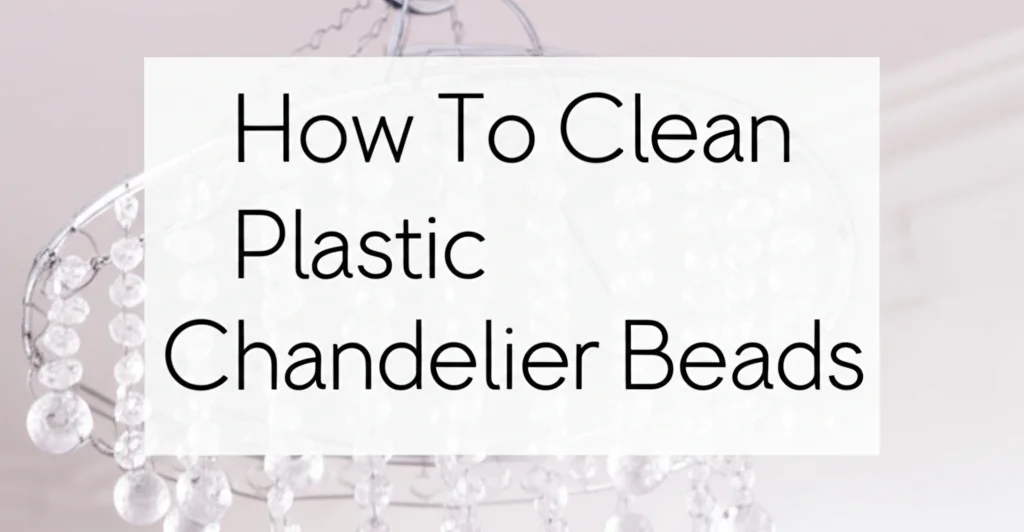· Home Cleaning · 6 min read
How To Clean Plastic Chandelier Beads

Sparkling Clean: How To Clean Plastic Chandelier Beads
Have you noticed your beautiful chandelier looking a little dull? Dust and grime can quickly accumulate on those delicate plastic beads, diminishing the fixture’s brilliance. Cleaning a chandelier might seem daunting, but it doesn’t have to be! This article will guide you through several effective methods for cleaning plastic chandelier beads, bringing back that dazzling sparkle. We’ll cover everything from gentle dusting techniques to more thorough cleaning solutions, ensuring your chandelier remains a stunning focal point in your home. Let’s get started and restore the beauty of your lighting!
Quick Answer: To clean plastic chandelier beads, gently dust with a microfiber cloth or soft brush. For tougher grime, use a mild soap and water solution, carefully wiping each bead. Rinse with clean water and allow to air dry completely.
Takeaway:
- Dust regularly to prevent buildup.
- Use gentle cleaning solutions to avoid damage.
- Always ensure the chandelier is completely dry before restoring power.
Why Plastic Chandeliers Need Regular Cleaning
Plastic chandeliers, while often more affordable than crystal alternatives, still require regular cleaning to maintain their appearance. Dust, grease from cooking, and even airborne pollutants can cling to the surface of the plastic beads, creating a film that reduces light reflection. This buildup not only makes the chandelier look dirty but can also diminish the overall brightness of the room. Regular cleaning prevents this buildup, ensuring your chandelier continues to illuminate your space beautifully. Think of it like washing your windows – a little effort goes a long way in maximizing light and creating a welcoming atmosphere.
Gathering Your Cleaning Supplies
Before you begin, it’s important to gather all the necessary supplies. Having everything within reach will make the cleaning process much smoother and more efficient. Here’s a checklist of what you’ll need:
- Microfiber cloths: These are essential for dusting and wiping without scratching the plastic.
- Soft-bristled brush: A paintbrush or small detailing brush is perfect for reaching tight spaces.
- Mild dish soap: Choose a gentle formula that won’t damage the plastic.
- Warm water: Avoid hot water, as it could potentially warp the plastic.
- Spray bottle: For mixing and applying the cleaning solution.
- Ladder or step stool: Ensure it’s stable and secure.
- Drop cloth or old towels: To protect the floor beneath the chandelier.
- Gloves (optional): To protect your hands.
The Gentle Dusting Method: Regular Maintenance
The easiest and most frequent cleaning method is simply dusting. Regular dusting prevents grime from building up and makes deeper cleaning less necessary. Use a dry microfiber cloth or a soft-bristled brush to gently wipe each bead. Start at the top of the chandelier and work your way down, catching any falling dust with a drop cloth below. This method is ideal for weekly or bi-weekly maintenance, keeping your chandelier looking its best with minimal effort. You can also use a can of compressed air to blow dust from hard-to-reach areas.
Deep Cleaning with Soap and Water
For chandeliers that haven’t been cleaned in a while, or have noticeable grime, a more thorough cleaning is required. Mix a small amount of mild dish soap with warm water in a spray bottle. Lightly spray the solution onto a microfiber cloth – never spray directly onto the chandelier, as this could cause water to drip into the electrical components. Gently wipe each bead, paying attention to areas with visible dirt. Remember to work systematically, starting at the top and moving downwards. This method effectively removes grease and grime, restoring the chandelier’s sparkle. If you’re looking for more information on floor cleaning, you might find this article helpful: https://www.beacleaner.com/how-to-clean-vinyl-plank-flooring/.
Dealing with Stubborn Grime
Sometimes, despite your best efforts, some grime just won’t budge. For these stubborn spots, you can try letting the soapy water solution sit on the bead for a minute or two before gently wiping it away. Avoid using abrasive cleaners or scrubbing too hard, as this could scratch the plastic. If the grime persists, consider repeating the process or trying a slightly stronger (but still mild) cleaning solution. A paste made from baking soda and water can also be effective, but test it on an inconspicuous area first to ensure it doesn’t damage the plastic.
Rinsing and Drying: The Final Steps
After cleaning, it’s crucial to rinse the chandelier to remove any soap residue. Use a clean microfiber cloth dampened with plain warm water to wipe each bead. Again, avoid spraying water directly onto the fixture. Once rinsed, allow the chandelier to air dry completely before turning the power back on. You can speed up the drying process by using a dry microfiber cloth to gently pat each bead dry. Ensuring the chandelier is completely dry is essential for safety and prevents potential electrical hazards. If you’re concerned about residue on other surfaces, check out this guide on https://www.beacleaner.com/how-to-remove-baking-soda-residue-from-carpet/.
Safety Precautions When Cleaning Chandeliers
Cleaning a chandelier involves working with electricity and heights, so safety should be your top priority. Always turn off the power to the chandelier at the circuit breaker before you begin cleaning. Use a stable ladder or step stool and ensure it’s placed on a level surface. Never stand on furniture to reach the chandelier. Avoid using harsh chemicals or abrasive cleaners, as these could damage the plastic beads or pose a health risk. If you’re uncomfortable cleaning the chandelier yourself, consider hiring a professional cleaning service. Remember, a little caution can prevent accidents and ensure a safe cleaning experience. For other cleaning tasks around the house, you might find this article on cleaning grout helpful: https://www.beacleaner.com/how-to-clean-floor-grout-without-scrubbing/.
Frequently Asked Questions (FAQ)
Q: Can I use glass cleaner on plastic chandelier beads? A: While some glass cleaners are safe for plastic, it’s best to avoid them. Many contain harsh chemicals that can damage or discolor the plastic over time. Stick to mild dish soap and water for the safest and most effective cleaning.
Q: How often should I clean my plastic chandelier? A: It depends on the environment. Dusting every 1-2 weeks and deep cleaning every 3-6 months is a good general guideline. If you live in a dusty area or cook frequently, you may need to clean it more often.
Q: What if some beads are very difficult to reach? A: A small detailing brush or a microfiber cloth wrapped around a long, thin object (like a ruler) can help you reach those tricky spots. Compressed air is also a great option.
Q: Can I use a steam cleaner on my plastic chandelier? A: It’s generally not recommended to use a steam cleaner on plastic chandeliers. The heat can potentially warp or damage the plastic beads.
Conclusion: Maintaining Your Chandelier’s Shine
Cleaning plastic chandelier beads doesn’t have to be a chore. By following these simple steps – regular dusting, gentle cleaning with mild soap and water, and careful drying – you can keep your chandelier looking its best for years to come. Remember to prioritize safety by turning off the power and using a stable ladder. A sparkling chandelier adds a touch of elegance to any room, and with a little effort, you can maintain its brilliance. So, go ahead and give your chandelier the attention it deserves! If you’re looking for more cleaning tips, you might find this article on cleaning floors helpful: https://www.beacleaner.com/how-to-clean-hardwood-floors-with-vinegar/.




